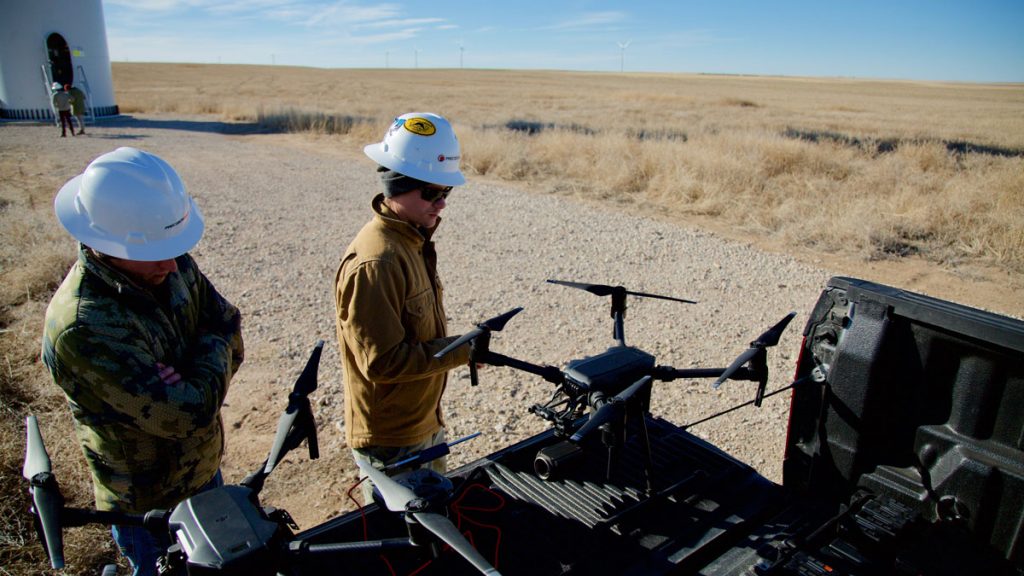In our Drone Service Provider Business Guide, you’ll learn how to earn an income flying drones. Read it now.
In this post, we’ll discuss the equipment you’ll need in the field, as well as business operations fundamentals like staffing, financial management, and customer experience.
Equipment and Tools
The following list includes the basic equipment and tools you’ll need to operate and maintain your drones.
1. Mobile Hotspot
A hotspot allows you to share your mobile network connection with other devices (i.e. a laptop) to access the internet. You’ll need a hotspot to access data on your laptop when Wi-Fi isn’t available.
2. Inverter Generator
An inverter generator will come in handy if you’re ever in an area where the utility power is unreliable. A backup generator will prepare you for any unexpected electrical emergencies.

3. Duplicate Onsite Hardware
“When it comes to hardware, two is one and one is none” according to PrecisionHawk’s Director of Flight Operations, Matt Tompkins. Bring backup drones, sensors, and batteries to avoid experiencing equipment failure during a job.
4. First Aid Kit
In the event of a minor workplace injury or ailment, have a first aid kit available to quickly respond to medical needs.
5. External SD Reader
You will need an external SD reader to store data if your laptop doesn’t come with one.
6. Aircraft Maintenance & Repair Tools
Have the following tools readily available for hardware repairs:
- Flat-blade Screwdriver
- Phillips Head Screwdriver
- Hex Key and Allen Wrenches
- Alcohol Wipes
- Wire Cutter Snips
- Electrical Tape

Hiring and Staff
As a business owner, it can be difficult deciding when you need to hire additional employees. If you’re just getting started, we recommend taking time to first understand your business and the industries you serve before hiring additional employees. However, as your business and client base grows, hiring employees may be necessary to generate additional income. Expanding your staff might be the right choice if your business is experiencing some of the following operational issues:
- You’re turning down business because you don’t have enough time to respond to customer requests.
- You’re delivering subpar customer service because you’re overextended.
- You want to expand into a new service line but you don’t have the time or skillset to do it on your own.
If you need more guidance on hiring and staffing, this article by Entrepreneur magazine walks you through how to decide when it is the right time to hire employees.
Financial Management & Record Keeping
To manage your finances and maintain accurate record keeping, we recommend using accounting software like QuickBooks or FreshBooks. You can link these applications to your bank account and credit cards, to track expenses, automate invoices, and generate reports.
Understanding Your Costs
To effectively manage your business, you need to understand how to identify and categorize your expenses. Expenses fall into two general categories: fixed cost and variable cost.
1. Fixed Costs
These are costs that are not affected by sales volume. These costs are consistent and must be paid regardless of your business’ profitability. Examples include rent, insurance, utilities, and loan payments. Finding ways to manage and reduce your fixed costs will increase your business’ profitability.
2. Variable Costs
These are costs that increase, or decrease, as sales volume changes. Examples of variable costs are supplies, labor, and sales commissions. It is important to understand your variable costs as it will affect how you price your services to ensure your sales are profitable.

Managing the Customer Experience
Providing an excellent customer experience is essential for the success of any business. You want to make every interaction with your business, from phone calls to website visits, a pleasant and worthwhile experience. Here are four ways to improve the customer experience:
1. Know Your Products and Services
Make yourself the expert on your products and services. Customers are coming to you to resolve their business issues and identify solutions. Be prepared to answer common questions and share information that adds value.
2. Engage In Active Listening
Active listening is the foundation of excellent customer service. Customers want to feel heard and understood. Pay attention to both verbal and non-verbal communication to ensure your delivering satisfactory solutions.
3. Be Responsive
Respond quickly to your customers. You never want to lose business because you responded too slowly to a customer who was trying to purchase a solution or find out more about your offerings.
4. Ask for Feedback and Implement Change
Find out what your customers think about your business by getting their feedback. While surveys are commonly used to gather customer feedback, you can add a personal touch by reaching out to clients directly for first-hand feedback. Once you receive feedback, put the data to work by identifying areas for improvement and making strategic changes to your business.
“The customer relationship is the driver for additional business. You must build relationships and trust.” -Daryl Watkins, VP of Insurance at PrecisionHawk
Get the Guide to Starting a Drone Business
To learn everything you need to know about starting your own drone business, read our Drone Service Provider Business Guide. Or speak with one of our experts today.